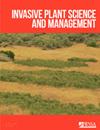利用叶核基因重建入侵结缕草(Reynoutria,蓼科)种群的系统发育关系
IF 1.2
4区 生物学
Q3 PLANT SCIENCES
引用次数: 2
摘要
虎杖属植物原产于东亚,但在欧洲和北美已成为有毒杂草。在美国,入侵种群日本结叶草(Reynoutria japonica Houtt.),巨型结叶草[Reynoutria sachalinensis (F. Schmidt) Nakai],以及它们的种间杂交品种波西米亚结叶草(R. x bohemica Chrtek & chrtkov本文章由计算机程序翻译,如有差异,请以英文原文为准。
Using the nuclear LEAFY gene to reconstruct phylogenetic relationships among invasive knotweed (Reynoutria, Polygonaceae) populations
Abstract Knotweed species in the genus Reynoutria are native to eastern Asia but have become noxious weeds in Europe and North America. In the United States, invasive populations of Japanese knotweed (Reynoutria japonica Houtt.), giant knotweed [Reynoutria sachalinensis (F. Schmidt) Nakai], and their interspecific hybrid known as Bohemian knotweed (R. × bohemica Chrtek & Chrtková) continue to expand their ranges. Although these plants are among the most invasive terrestrial species, there are relatively few molecular tools for identifying the parental species, the F1 hybrid, or subsequent hybrids or introgressed individuals. We studied Reynoutria populations in Wisconsin, a state where all three taxa grow, to determine whether molecular data would be useful for distinguishing species and identifying hybrids. We obtained DNA sequence data from the plastid matK gene and the nuclear LEAFY gene and compared these to previously published sequences. Data from the uniparentally inherited matK region included haplotypes attributable to R. japonica and R. sachalinensis. Nuclear data indicated that R. sachalinensis plants are most similar to native plants in Japan, with two Wisconsin accessions exhibiting a monomorphic genotype for the LEAFY gene. Three Wisconsin accessions of R. japonica were each characterized by having three distinct kinds of LEAFY sequence. Most plants in our study were found to possess two or three phylogenetically distinct copies of the LEAFY gene, with the copies being most closely related to R. japonica and R. sachalinensis, respectively, and these were inferred to be interspecific hybrids. Altogether, five kinds of interspecific hybrids were identified, reflecting various combinations of LEAFY sequence types from the parental species. The widespread existence of hybrid plants in Wisconsin, many of which are morphologically identifiable as R. japonica, indicates a cryptic genetic diversity that should be examined more broadly in North America using molecular tools.
求助全文
通过发布文献求助,成功后即可免费获取论文全文。
去求助
来源期刊

Invasive Plant Science and Management
PLANT SCIENCES-
CiteScore
2.20
自引率
9.10%
发文量
24
审稿时长
6-12 weeks
期刊介绍:
Invasive Plant Science and Management (IPSM) is an online peer-reviewed journal focusing on fundamental and applied research on invasive plant biology, ecology, management, and restoration of invaded non-crop areas, and on other aspects relevant to invasive species, including educational activities and policy issues. Topics include the biology and ecology of invasive plants in rangeland, prairie, pasture, wildland, forestry, riparian, wetland, aquatic, recreational, rights-of-ways, and other non-crop (parks, preserves, natural areas) settings; genetics of invasive plants; social, ecological, and economic impacts of invasive plants and their management; design, efficacy, and integration of control tools; land restoration and rehabilitation; effects of management on soil, air, water, and wildlife; education, extension, and outreach methods and resources; technology and product reports; mapping and remote sensing, inventory and monitoring; technology transfer tools; case study reports; and regulatory issues.
 求助内容:
求助内容: 应助结果提醒方式:
应助结果提醒方式:


